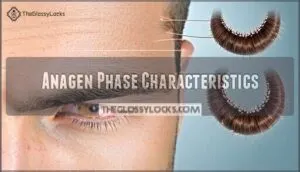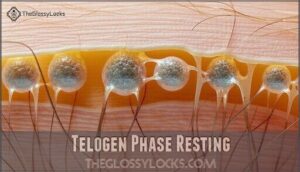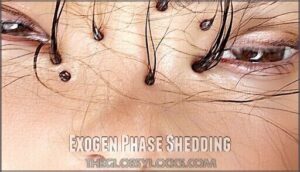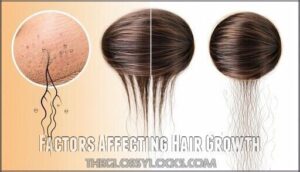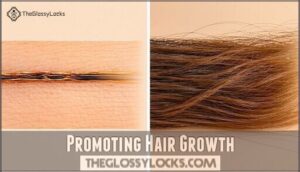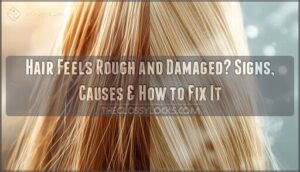This site is supported by our readers. We may earn a commission, at no cost to you, if you purchase through links.
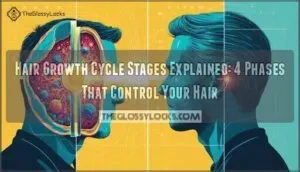 Your hair doesn’t grow like a continuous conveyor belt—it follows a precise four-stage cycle that controls when each strand grows, rests, and sheds.
Your hair doesn’t grow like a continuous conveyor belt—it follows a precise four-stage cycle that controls when each strand grows, rests, and sheds.
The hair growth cycle stages explained break down into anagen (active growth lasting 2-7 years), catagen (transition phase of 2-3 weeks), telogen (resting period of 2-3 months), and exogen (shedding phase).
During anagen, your hair follicles work overtime, producing new cells that push the hair shaft upward.
Understanding these phases helps explain why you lose 50-100 hairs daily—it’s perfectly normal.
Each follicle operates independently, cycling through these stages at different times.
This natural rhythm determines your hair’s length potential, thickness, and overall health patterns.
Table Of Contents
- Key Takeaways
- Hair Growth Basics
- Hair Cycle Stages
- Factors Affecting Hair Growth
- Maintaining Healthy Hair
- Promoting Hair Growth
- Frequently Asked Questions (FAQs)
- What is the most effective stage of hair growth?
- What are the 4 stages of the hair growth cycle?
- How long does it take for hair to go through a full cycle?
- How long does each stage of hair growth take?
- How do I know what phase my hair is in?
- Does shedding hair mean it’s growing?
- What is the 7 year hair cycle?
- How does hair color change over time?
- What is the impact of aging on hair growth?
- Can hair growth be accelerated through supplements?
- Conclusion
Key Takeaways
- Your hair grows through four distinct stages: anagen phase (active growth lasting 2-7 years), catagen (2-3 week transition), telogen (2-3 month resting period), and exogen (shedding phase) – understanding these phases helps you recognize that losing 50-100 hairs daily is completely normal.
- You can’t speed up your hair’s natural growth rate beyond half an inch per month, but you can optimize conditions through proper nutrition and care, stress management, and gentle care techniques that support your follicles throughout each cycle stage.
- Your hair’s maximum length potential is determined by how long your anagen phase lasts – this varies by genetics and can be shortened by factors like stress, hormonal changes, or nutrient deficiencies that disrupt the natural cycle.
- Timing matters when it comes to hair treatments and expectations – since each follicle cycles independently and the complete process takes 2-7 years, you’ll need patience and consistency to see meaningful changes in your hair’s health and appearance.
Hair Growth Basics
Your hair grows from millions of tiny structures called follicles that you develop before birth.
Each follicle contains everything needed to produce a single hair strand that pushes up through your skin at a steady rate of about half an inch per month.
Your hair factory works around the clock, manufacturing half an inch of growth monthly.
Hair Follicle Structure
Beneath your skin’s surface, hair follicles function like tiny manufacturing plants.
Each follicle development begins early in fetal life, creating tubular structures that extend from your epidermis into the dermis.
The papilla function at each follicle’s base houses blood vessels that deliver essential nutrients.
These keratin layers form through specialized cells that create your hair’s foundation, while sebum production from attached glands naturally conditions each strand.
Hair Shaft Composition
How does your hair’s architecture determine its strength and appearance?
Your hair shaft contains three distinct layers that work together to create what you see and feel.
Each strand consists of:
- Medulla – the innermost core (not always present)
- Cortex – the middle layer containing pigment cells
- Cuticle – protective outer scales overlapping like shingles
- Keratin Structure – the protein foundation throughout all layers
The cortex holds your hair’s color, while cuticle scales protect the inner components and affect shine.
Hair Growth Rate
Your hair growth rate averages half a millimeter daily, roughly six inches annually.
Seasonal variation boosts summer growth by 10%, while genetic predisposition sets your baseline speed.
Age influence slows growth after menopause, and ethnicity factors show Asian hair grows fastest at 13.9mm monthly.
Product impact and styling choices can mask natural anagen phase progress, affecting your hair growth cycle stages perception.
Understanding the hair growth factors is essential for maintaining healthy hair and addressing potential growth issues.
Hair Cycle Stages
Your hair doesn’t grow continuously but follows a precise four-stage cycle that determines when each strand grows, rests, and eventually falls out.
Understanding these phases helps explain why you shed hair daily and why growth seems to slow or accelerate at different times, which is influenced by the cycle.
Anagen Phase Characteristics
The anagen phase represents your hair’s peak performance period, lasting several years for scalp hair.
During this active growth stage, rapid cell division occurs at the follicle base, determining hair thickness and growth patterns.
Healthy follicles maintain consistent anagen duration, directly controlling your hair’s maximum length potential and overall appearance.
Understanding the hair growth phases is essential for maintaining healthy hair and addressing potential disruptions to the hair growth cycle.
Catagen Phase Transition
After your hair’s active anagen phase ends, the catagen phase begins—a brief but critical phase lasting just 2-3 weeks.
During this follicle shift, your hair follicles rapidly shrink and detach from their blood supply, causing growth pause. Only 1-5% of your scalp hair enters this hair regression stage simultaneously.
Cell renewal stops as follicle cells undergo programmed death, preparing for the upcoming telogen phase. Understanding the hair growth cycle is essential to recognize the significance of each stage in hair development.
Telogen Phase Resting
After your hair completes its growth journey, it typically enters the telogen phase, often called the resting phase.
During this three-month period, your follicles become dormant while the hair shaft remains anchored.
About 10-15% of your scalp hairs rest simultaneously, and this follicle dormancy prepares for the next hair regrowth cycle.
This makes telogen duration essential for healthy hair shedding patterns.
Exogen Phase Shedding
Finally, when your hair follicle completes the telogen phase, it enters the exogen phase shedding stage.
During this phase, old hair strands naturally detach from your scalp while new growth begins underneath.
You’ll typically lose 50-100 hairs daily through normal exogen phase hair shedding.
This follicle renewal process guarantees continuous scalp health and maintains your hair growth cycle stages.
Factors Affecting Hair Growth
Your hair’s growth depends on several key factors that work together to determine how fast and healthy your strands develop.
Understanding nutrition, stress levels, and hormones helps you create the best conditions for ideal hair growth.
Nutrition and Hair Health
Your plate becomes your hair’s foundation.
Protein-rich foods like lean meats and beans provide amino acids essential for keratin production.
Iron deficiency affects up to 30% of women, triggering hair shedding.
Vitamin D regulates hair growth cycle stages, while omega-3 fatty acids reduce scalp inflammation.
Nutrient deficiencies from crash dieting can disrupt healthy hair growth within months. A balanced diet that includes hair growth vitamins is essential for maintaining healthy hair.
Stress Impact on Hair
Chronic stress wreaks havoc on your hair growth cycle, pushing follicles prematurely into telogen phase.
Elevated cortisol levels disrupt normal hair cycle stages, causing telogen effluvium – widespread hair loss months after stressful events.
You can combat stress and hair loss through mindful relaxation techniques like meditation and yoga, supporting emotional wellness while protecting your hair growth cycle from disruption, which helps in maintaining a healthy hair cycle.
Hormonal Influences on Hair
When hormone balance shifts, your hair cycle disruption follows like a shadow.
Thyroid effects directly control growth phases—hypothyroidism slows anagen phase while hyperthyroidism accelerates telogen phase shedding.
Pregnancy hair thrives from elevated estrogen, but postpartum drops trigger massive shedding.
Menopause hair thins as estrogen plummets.
Androgen impact creates male-pattern baldness through DHT miniaturization of follicles.
Understanding the role of hormone balance is essential in addressing hair growth issues.
Maintaining Healthy Hair
Now that you understand how hair grows through its four phases, you’ll want to support this natural cycle with proper care techniques.
Your daily habits and lifestyle choices directly impact whether your hair reaches its full growth potential or falls short due to preventable damage, which can be influenced by proper care.
Proper Hair Care Techniques
Taking care of your hair throughout the growth cycle requires consistent attention to your hair care routine.
Focus on these essential techniques:
- Hair Washing: Use lukewarm water and gentle shampoos suited for your hair type
- Scalp Massage: Stimulate blood flow with circular motions during washing
- Hair Trimming: Remove split ends every 6-8 weeks to prevent damage
- Product Selection: Choose conditioners that match your hair’s specific needs
- Styling Tips: Minimize heat exposure and use protective products when styling
Using the right hair growth products can greatly enhance the effectiveness of your hair care routine.
Reducing Stress for Hair Health
Stress acts like a thief, stealing nutrients from your hair follicles and disrupting the hair growth cycle.
When cortisol levels spike, your strands enter premature resting phases.
Stress hijacks your hair growth cycle, forcing healthy strands into early retirement.
Combat this with meditation techniques and mindful breathing exercises.
Yoga practices offer dual benefits—reducing tension while boosting scalp circulation.
These relaxation methods help maintain ideal conditions for healthy hair growth, utilizing relaxation methods and promoting healthy hair growth.
Essential Nutrients for Hair Growth
Your body needs specific building blocks to fuel hair growth and nutrition factors play a vital role.
Protein sources like lean meats and beans provide keratin foundation, while vitamin benefits from C and D support follicle health.
Mineral deficiencies, especially iron supplements for women, can disrupt growth cycles. Nutrient balance through hair growth and vitamins creates ideal conditions for hair growth promotion and stronger strands.
Understanding the hair growth basics is essential for creating an effective hair care routine.
Promoting Hair Growth
Understanding your hair growth cycle helps you make better decisions about promoting stronger, healthier hair.
You can use this knowledge to time treatments effectively and create routines that support your hair’s natural growth phases.
Increasing Blood Flow to Scalp
Scalp massage acts like a gentle wake-up call for your hair follicles.
When you massage your scalp, you’re boosting blood flow to those tiny capillaries that feed each follicle. This increased circulation delivers more oxygen and nutrients directly to the hair root, supporting healthier growth throughout the hair growth cycle and promoting ideal scalp health.
Regular use of a scalp massager tool can further enhance the benefits of scalp massage for hair growth, and by doing so, it aids in maintaining ideal scalp health.
Stimulating Hair Growth Naturally
Beyond scalp massage, several natural approaches can extend your hair’s anagen phase and support healthy follicles.
Natural oils like rosemary and peppermint stimulate circulation when massaged into the scalp.
Dietary supplements containing biotin, omega-3s, and iron nourish follicles from within.
Herbal remedies such as ginseng and onion juice enhance the hair growth cycle explanation through improved nutrient delivery to each hair follicle, supporting overall hair growth.
Reducing Hair Shedding Techniques
After boosting growth naturally, it’s smart to tackle hair shedding head-on.
Start with gentle combing and avoid tugging at wet strands. Regular scalp massage improves blood flow, helping your hair follicles stay strong through the telogen phase.
Use mild shampoos, and don’t skip protein-rich meals. These steps support shedding prevention, encourage hair thickening, and keep the hair growth cycle balanced—even during the exogen phase.
Understanding the role of genetic factors can also help in addressing hair loss effectively.
Frequently Asked Questions (FAQs)
What is the most effective stage of hair growth?
Approximately 85% of your hair stays in anagen, making this the most effective growth stage.
You’ll see the best results during anagen since it’s when follicles actively produce new hair for several years.
What are the 4 stages of the hair growth cycle?
Your hair goes through four distinct stages: anagen (active growth lasting years), catagen (brief intermediate phase), telogen (resting period), and exogen (shedding stage when old hairs fall out).
How long does it take for hair to go through a full cycle?
Like a marathon rather than a sprint, your hair’s complete journey takes 2-7 years.
The cycle includes anagen (growth phase lasting several years), catagen (brief interim weeks), and telogen (3-month rest period).
How long does each stage of hair growth take?
Your hair’s anagen (growth) phase lasts several years for scalp hair.
The catagen (transition) phase runs just a few weeks.
How do I know what phase my hair is in?
Identifying your hair’s growth phase isn’t directly visible, but you can observe clues.
Count daily shedding—50-100 hairs suggests normal cycling.
Check thickness and growth rate changes over months to determine phase.
Does shedding hair mean it’s growing?
Shedding hair doesn’t necessarily mean new growth—it’s part of your hair’s natural cycle.
When follicles complete the telogen (resting) phase, old hairs shed to make room for new anagen (growth) phase hairs.
What is the 7 year hair cycle?
Your scalp hair doesn’t follow a seven-year cycle. Instead, it grows in three phases: anagen (growth for several years), catagen (transition for weeks), and telogen (rest for three months).
How does hair color change over time?
Your hair changes color like autumn leaves transforming through seasons.
As you age, melanin production in your hair follicles gradually decreases, causing pigment loss and eventual graying or whitening of your hair strands over time.
What is the impact of aging on hair growth?
As you age, your hair growth slows down, follicles shrink, and the anagen phase shortens. You’ll notice thinner strands, reduced density, and slower regrowth after hair loss occurs.
Can hair growth be accelerated through supplements?
Certain supplements like biotin, vitamin D, and iron can support healthy hair growth when you’re deficient.
They won’t accelerate growth beyond your natural rate of approximately half an inch monthly.
Conclusion
Think of your hair follicles as tiny factories with their own precise schedules.
Understanding the hair growth cycle stages explained empowers you to make informed decisions about your hair care routine.
You’ll know why patience matters during growth phases and when shedding’s completely normal.
By recognizing how anagen, catagen, telogen, and exogen phases work together, you can optimize nutrition, manage stress, and choose treatments that align with your hair’s natural rhythm for healthier, stronger strands.

